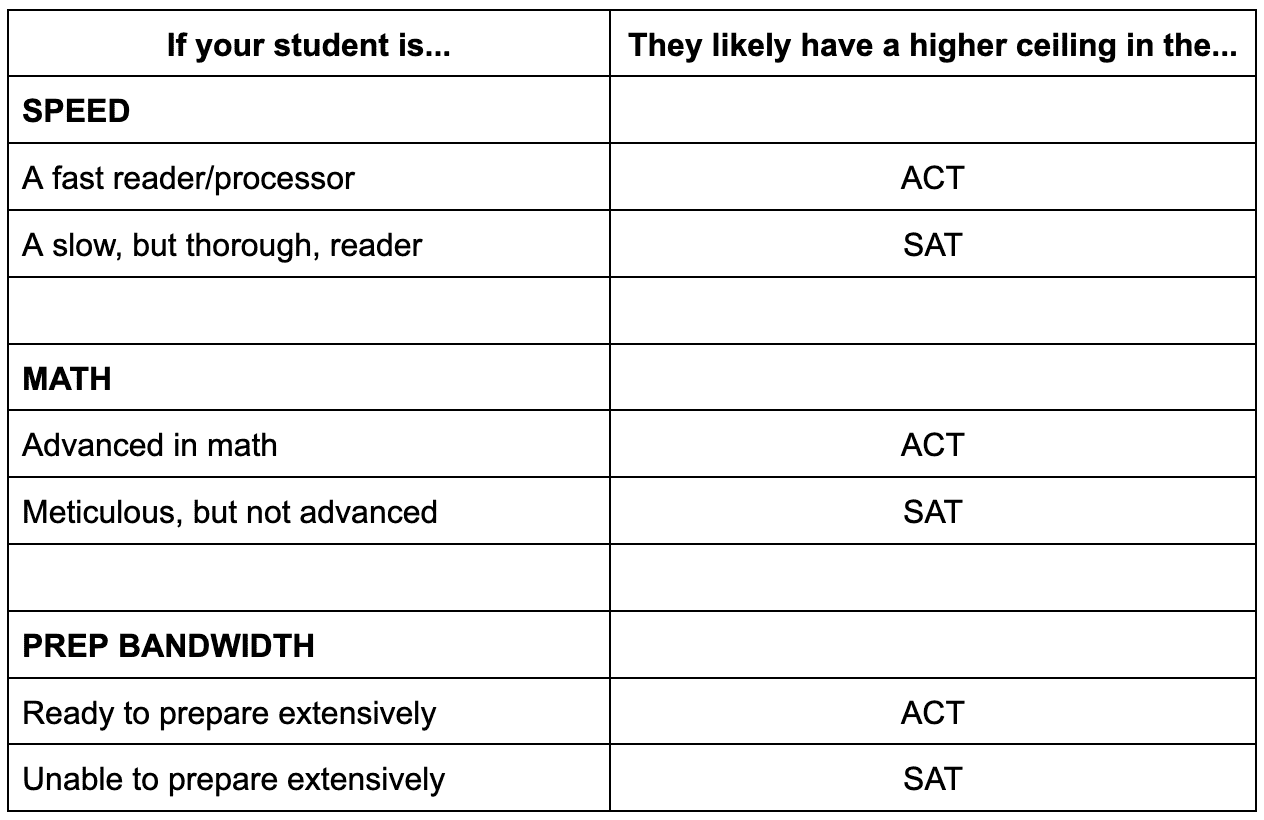
Despite the changes the SAT made in 2016 to the exam that made it more akin in format to the ACT, significant differences remain. This is good news, as it provides two groups of students with a test that aligns with their skillsets. You may know with certainty which test is better for your student after reading the below. But for most families, the best option is to have a student take a full diagnostic exam in each test or a hybrid half-SAT/half-ACT exam with a company like Top Score. A trained professional can look at the performance and provide insight about where the ceiling might be higher. Also, the student may have a strong gut feeling about which side of the test better fits their learning style. Find here some key differences between the tests and which test might fit a certain student profile. I have listed them from most to least important differentiators.
Speed
The ACT exam is the faster test, by far. Students who have a high processing speed and are fast readers tend to do better on the ACT, which is more straightforward, less wordy, and less subjective than the SAT. This impacts the respective reading comprehension sections most directly: the ACT questions are much simpler but students have much less time to read, find evidence, and select their answers. The SAT exam provides students with more time to read, but the passages are denser (including 19th century literature and history source documents) and questions more nuanced.
One caveat: if you have accommodations for extra time, the ACT is the better test, because with time limits extended at least 50%, a major obstacle has been removed or at least mitigated. In the SAT, extended time may be useful, but since the Verbal passages and questions tend to be more difficult, the extra time won’t necessarily address the main challenge of processing the more profound material.
Math
The ACT exam covers more advanced math (think vectors, matrices, logarithms, ellipses, polynomial expansion, sequences, law of sines/cosines) and a broader range of math curricula (Algebra 1 through Precalculus, including lots of Geometry). The SAT exam asks deeper questions about less advanced and fewer math topics, with more emphasis on word problems and application. Focus is much more on fractions, linear, quadratic and exponential functions, and data analysis from tables. A majority of the math is from Algebra 1, with a little from Geometry and only moderately advanced principles from Algebra 2. The SAT also contains a non-calculator math section, a possible negative for students who lean on their calculator for school math courses.
Science
Both the ACT and the SAT exams have elements of science. The ACT has a separate Science section, which is focused more on data interpretation and general experimental investigation than memorized science facts. A strong science student should have an advantage, but fast processing and data analysis are still more impactful on the final score.
Prep Bandwidth
For both tests, a great deal of hard work is required, but the ACT remains a more straightforward exam on facts while the SAT requires more interpretation. That delivers greater advantage to students taking the ACT who are willing to really put the work in and push themselves to learn that content and practice strong testing strategies. The SAT’s slightly more intuitive nature benefits strong testers/readers who don’t have the time or motivation to study the advanced math, grammar rules, and science strategies necessary to ace the ACT. So your “smart slacker” may be better suited for the SAT.
The Curve
Though not a true curve process, all SAT and ACT exams are “equated” to account for variances in difficulty from one test to the next. Thus a 540 SAT or 28 ACT Math score on a June test means the same thing as a test with completely different questions taken by different students later that year in December. The harder the exam, the more questions students will miss, the friendlier the “curve.” How this comes into play are the trends in recent years in the grammar and math sections of the two exams. The ACT has skewed more challenging in its English (grammar) and Math sections, resulting in much friendlier scales for top students who prepare rigorously and can handle tough but straightforward grammar and advanced math questions. The SAT has skewed less challenging in the same two subjects, but with a resulting tightening of the scale. So taking the SAT Math, you are facing much easier math questions but every error will really cost you: there is no room for misstep. An advanced math student will then likely fare better on the ACT Math, as they can leverage that top end content knowledge. On the SAT, they lose that advantage, and if prone to careless mistakes can see a score plummet well below their actual math ability.
Many students are taking both tests these days, which I think could and should be avoided by putting in a little more time and effort up front to identify the right exam and throw full effort into that one format. Skipping the 4-5 hours of diagnostic work might cost you 25-30 hours of extra work down the line in duplicative test study and exam attempts. As they say, a stitch in time saves nine. Who says that? British people? Your Nonna?
So the quick breakdown for those keeping score at home (or who got bored around the point I mentioned equating).

